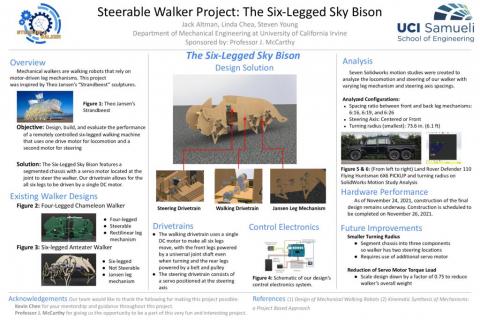Steerable Walker
Background
The goal of this project is to design, build and evaluate the performance of a six-legged walking machine that uses one drive motor for locomotion and a second drive motor for steering. An RC transmitter and receiver will be used to provide user control of the drive and steering motors. The walker should be constructed from parts that are readily available for on-line purchase or can be manufactured remotely using UCI facilities. Assembly should require tools available to the hobbyist. It should be sized so that it is portable, and can move at approximately 1.5 fps.
Background information is available at the YouTube site: https://www.youtube.com/channel/UC5ZQHc5wBkzqhG5TpsZYGwg
Deliverables: A demonstration of the six-legged walking machine moving through a set of obstacles under RC control.
Goal and Objectives
The goal of this project is to design, construct, and demonstrate a six-legged steerable mechanical walker. The walker will be minimally actuated with 2-4 actuators, be no larger than 18”x30”, and have a chassis made out of Baltic birch. The walker will also be steerable using an RC or Infrared controller, have a walk speed of 1.5 feet per second, and have a steering angle of 25 degrees.
There will be two demonstrations that will serve as milestones for the project. The first demonstration, which will occur at the midterm of the quarter, will include two assembled leg mechanisms, the walking drive train, the steering drive train, and the control system. The second demonstration, which will occur at the end of the quarter, will include the completed six-legged walker and will display the walker’s ability to move in a straight line at the intended speed and move in a circle to the left and right with the desired turning radius.
Additional Goals
If time allows, we would like to explore more with building our walker to have three separated segments. In this way, each of the segments has a leg. The challenge that we have with this goal is figuring out how the steering mechanism would work. Another part that we can further experiment with is the leg mechanism. We can try to design another type of leg mechanism to see between the two, which performs better.
Team Contacts
Jack Altman: jtaltman@uci.edu
Linda Chea: cheal1@uci.edu
Steven Young: swyoung1@uci.edu
Sponsor/Advisor
Prof. J. Michael McCarthy: jmmccart@uci.edu

